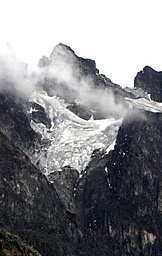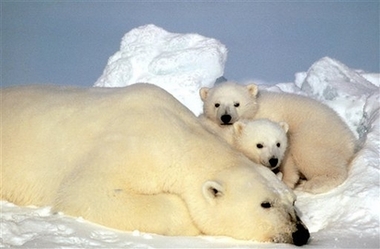Thursday, November 30, 2006
Tuesday, November 28, 2006
Climate change melting fabled glaciers
Climate Change and Amphibian Population Declines in Spain
Working within the Penalara Natural Park in the Sierra de Guadarrama of Central Spain, Bosch et al. looked for relationships between 20 different meteorological variables and the development of chytridiomycosis infection in the area's amphibian populations, focusing on "two time periods according to the lack (1976-1996) or presence (1997-2003) of observed chytrid-related mortalities."
Gaia scientist Lovelock predicts planetary wipeout
 Sunlight is shown over a cloud-covered Earth surface in this image taken by crew members onboard the Shuttle Discovery March 18, 1989. The earth has a fever that could boost temperatures by 8 degrees Celsius making large parts of the surface uninhabitable and threatening billions of peoples' lives, a controversial climate scientist said on Tuesday. FOR EDITORIAL USE ONLY (NASA/Handout/Reuters)
Sunlight is shown over a cloud-covered Earth surface in this image taken by crew members onboard the Shuttle Discovery March 18, 1989. The earth has a fever that could boost temperatures by 8 degrees Celsius making large parts of the surface uninhabitable and threatening billions of peoples' lives, a controversial climate scientist said on Tuesday. FOR EDITORIAL USE ONLY (NASA/Handout/Reuters)LONDON (Reuters) - The earth has a fever that could boost temperatures by 8 degrees Celsius making large parts of the surface uninhabitable and threatening billions of peoples' lives, a controversial climate scientist said on Tuesday.
Sunday, November 26, 2006
Wednesday, November 22, 2006
Global warming said killing some species

Seagulls in flight, June 2003. Nearly three quarters of all bird species in northeast Australia and more than a third in Europe could become extinct unless efforts to stop global warming are stepped up, a report said.(AFP/File/Marcel Mochet)
These fast-moving adaptations come as a surprise even to biologists and ecologists because they are occurring so rapidly.
At least 70 species of frogs, mostly mountain-dwellers that had nowhere to go to escape the creeping heat, have gone extinct because of climate change, the analysis says. It also reports that between 100 and 200 other cold-dependent animal species, such as penguins and polar bears are in deep trouble.
"We are finally seeing species going extinct," said University of Texas biologist Camille Parmesan, author of the study. "Now we've got the evidence. It's here. It's real. This is not just biologists' intuition. It's what's happening."
Friday, November 17, 2006
Iceberg spotted from New Zealand shore
 In the photo relaesed by the New Zealand Defense Department, an iceberg drifts off the coast of New Zealand in this Nov 3, 2006. The icebergs - two large ones and several smaller chunks - have sparked overseas interest as people clamour to view a once-in-a-lifetime occurrence that are now only a 30 minute helicopter flight from the southern city of Dunedin. (AP Photo/New Zealand Defense Department, HO)
In the photo relaesed by the New Zealand Defense Department, an iceberg drifts off the coast of New Zealand in this Nov 3, 2006. The icebergs - two large ones and several smaller chunks - have sparked overseas interest as people clamour to view a once-in-a-lifetime occurrence that are now only a 30 minute helicopter flight from the southern city of Dunedin. (AP Photo/New Zealand Defense Department, HO)The giant ice chunk was visible Thursday from Dunedin on South Island but has since moved away, driven by winds and ocean currents. The flotilla of icebergs — some as big as houses — were first spotted south of New Zealand early this month.
Last year, icebergs were seen in the country's waters for the first time in 56 years. But the last time one was visible from the New Zealand shore was June 1931, said Mike Williams, an oceanographer at the National Institute of Water & Atmospheric Research.
Wednesday, November 15, 2006
Kenya appeals for help as flood devastation spreads
Ice-melt isolates remote communities in Canada

Graphic shows the region of northern Ontario represented by Nishnawbe Aski Nation, where 34 Aboriginal communities are accessible only by air for most of the year. Bulk goods are shipped in the winter over frozen rivers and lakes, but the shipping season is shrinking as average temperatures rise. (Graphic/Reuters)
"The ice doesn't have its solid blue color any more," said Stan Beardy, the grand chief of Nishnawbe Aski Nation, which represents Ontario's remote First Nations. "It's more like Styrofoam now, really brittle."
"With the toxic waste moving north, and global warming, we don't have that solid ice anymore, and that's why we have problems with winter roads when it's mild."
Scientists: Climate change fueling fires
The wildfire season that just ended in the U.S. was the most severe — and expensive — on record with more than 89,000 fires scorching 9.5 million acres, according to the National Interagency Fire Center. The U.S. Forest Service spent $1.5 billion fighting those fires — about $100 million over budget.
Less polar bear cubs surviving in Alaska
Icebergs becoming tourist attraction

The icebergs were about 100 kilometres (60 miles) off the Otago coast in the south-east of the country Wednesday, the closest sighting off New Zealand for 75 years, The National Institute of Water and Atmospheric Research (NIWA) said.
Helicopters have been taking scientists and sightseers out to view the massive slabs of ice. One is about 500 metres (1,600 feet) long, 50 metres wide and 60 metres high, while the other has a 100 metre high peak and is about 300 metres long.
Insomniac Russian Bears
 A four-month-old bear cub looks around as it is released for the first time outside a family farm some 400 km west of Moscow, April 12, 2005. Insomniac bears are roaming the forests of southwestern Siberia scaring local people as the weather stays too warm for the animals to fall into their usual winter slumber. (Sergei Karpukhin/Reuters)
A four-month-old bear cub looks around as it is released for the first time outside a family farm some 400 km west of Moscow, April 12, 2005. Insomniac bears are roaming the forests of southwestern Siberia scaring local people as the weather stays too warm for the animals to fall into their usual winter slumber. (Sergei Karpukhin/Reuters)
Sunday, November 12, 2006
Venice mayor: Flood barriers a mistake
Venice
 A dog advances on a flooded terrace facing San Marco square in Venice, October 2006. Rising sea levels and ocean temperatures, floods and other calamities linked to global warming threaten natural and manmade cultural sites around the world, ncluding Venice, the United Nations has said.(AFP/File/Sebastiano Casellati)
A dog advances on a flooded terrace facing San Marco square in Venice, October 2006. Rising sea levels and ocean temperatures, floods and other calamities linked to global warming threaten natural and manmade cultural sites around the world, ncluding Venice, the United Nations has said.(AFP/File/Sebastiano Casellati)
Thursday, November 09, 2006
Global Warming Could Trigger Insect Population Boom
New research shows that insect species living in warmer areas are more likely to undergo rapid population growth because they have higher metabolic rates and reproduce more frequently. The finding has scientists concerned that global warming could give rise to more fast-growing insect populations and that we could see a spike in the number of six-legged critters.
The consequences could be more serious than just a few extra bug bites each summer. “If they’re crop species, we could count on needing to use more pesticides and it could be very costly,” said Melanie Frazier, a doctoral student at the University of Washington and lead author of the study.
Malaria surge in Kenyan highlands may be tied to global warming
Amid continuing debate over the health consequences of climate change, specifically the spread of vector-borne afflictions like malaria, scientists reported growing cases in the highlands that correspond to higher temperatures.
"Malaria is the most climate-sensitive, vector-borne disease affecting most of the African population," said Andrew Githeko, a researcher with Kenya Medical Research Institute (KEMRI) Tuesday.
Expert says Australian drought is 'worst in 1,000 years'
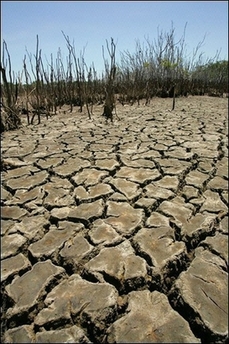 The drought ravaged Gayngaru wetlands of Arnhem Land in the Northern Territory. Australia, already the world's driest inhabited continent, is in the grip of its worst drought in 1,000 years, a leading expert told the country's political leaders at a crisis summit.(AFP/File/Torsten Blackwood)
The drought ravaged Gayngaru wetlands of Arnhem Land in the Northern Territory. Australia, already the world's driest inhabited continent, is in the grip of its worst drought in 1,000 years, a leading expert told the country's political leaders at a crisis summit.(AFP/File/Torsten Blackwood)Conservative Prime Minister John Howard and premiers of the three worst-hit states were presented with the bleak assessment at the meeting in Canberra by an expert on the country's most significant river system, participants said.
The drought has already been described variously as the worst in living memory, the worst in a century and the worst since white settlement more than two centuries ago.
Climate change: Greenland and Antarctica aren't poles apart, says study
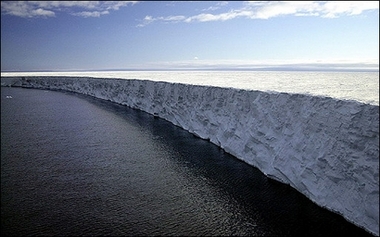 The shear face of the massive B-15A iceberg stretches for 150 kms across McMurdo Sound after it broke off the Ross Ice Shelf in Antartica in 2001. Greenland and Antarctica are at opposite ends of the planet but their climate systems appear to be linked by a remarkable ocean current, according to a study appearing.(AFP/NSF-HO/File)
The shear face of the massive B-15A iceberg stretches for 150 kms across McMurdo Sound after it broke off the Ross Ice Shelf in Antartica in 2001. Greenland and Antarctica are at opposite ends of the planet but their climate systems appear to be linked by a remarkable ocean current, according to a study appearing.(AFP/NSF-HO/File)Greenland and Antarctica are at opposite ends of the planet but their climate systems appear to be linked by a remarkable ocean current, according to a study appearing.
Icebergs near NZ after drifting from Atlantic
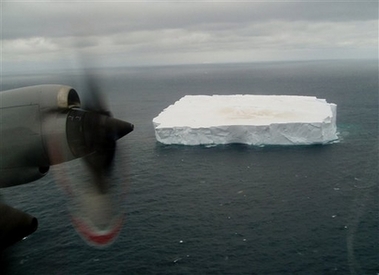 In this undated photo released by the New Zealand Defense Force, an iceberg is observed from a New Zealand Air Force P3 Orion maritime surveillance airplane on routine fisheries patrol in the southern ocean. A maritime warning has been issued after approximately 100 icebergs were discovered near Auckland Islands, 260 kilometers (160 miles) south of the South Island of New Zealand Friday, Nov. 3, 2006. The largest iceberg about 2 kilometers by 1.5 kilometers (1.2 by 0.9 miles) and more than 130 meters (425 feet) high were found floating in a major ocean shipping lane. (AP Photo/New Zealand Defense Force,HO)
In this undated photo released by the New Zealand Defense Force, an iceberg is observed from a New Zealand Air Force P3 Orion maritime surveillance airplane on routine fisheries patrol in the southern ocean. A maritime warning has been issued after approximately 100 icebergs were discovered near Auckland Islands, 260 kilometers (160 miles) south of the South Island of New Zealand Friday, Nov. 3, 2006. The largest iceberg about 2 kilometers by 1.5 kilometers (1.2 by 0.9 miles) and more than 130 meters (425 feet) high were found floating in a major ocean shipping lane. (AP Photo/New Zealand Defense Force,HO)The original iceberg, named A-43, was 167 km (104 miles) long 32 km (20 miles) wide.
Polar ice cores show "bipolar seesaw" climate link
 Reuters Photo: A million-year-old Antarctic ice sample is displayed in Tokyo April 18, 2006. New ice cores...
Reuters Photo: A million-year-old Antarctic ice sample is displayed in Tokyo April 18, 2006. New ice cores...